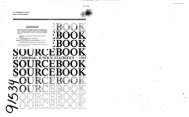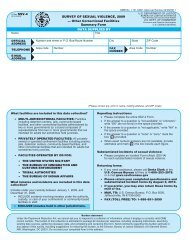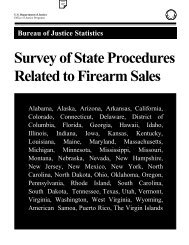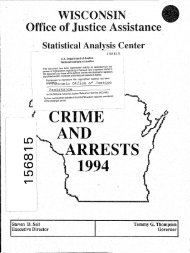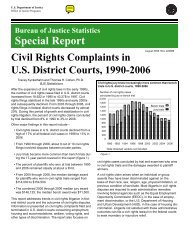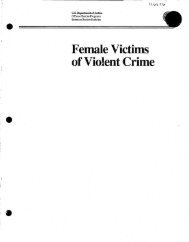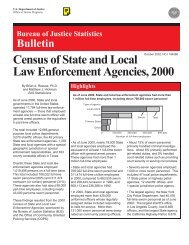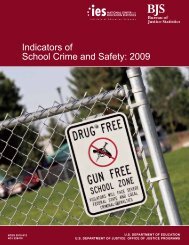Population Density in State Prisons - Bureau of Justice Statistics
Population Density in State Prisons - Bureau of Justice Statistics
Population Density in State Prisons - Bureau of Justice Statistics
Create successful ePaper yourself
Turn your PDF publications into a flip-book with our unique Google optimized e-Paper software.
u.s. Department <strong>of</strong> <strong>Justice</strong><strong>Bureau</strong> <strong>of</strong> <strong>Justice</strong> <strong>Statistics</strong>...<strong>Population</strong> <strong>Density</strong><strong>in</strong> <strong>State</strong> <strong>Prisons</strong>By Christopher A. Innes, Ph.D.BJS StatisticianThe 694 <strong>State</strong> prisons <strong>in</strong> operation onJune 30, 1984, provided an average <strong>of</strong> 57square feet <strong>of</strong> liv<strong>in</strong>g space per <strong>in</strong>mate<strong>in</strong> general and special hous<strong>in</strong>g andconf<strong>in</strong>ed <strong>in</strong>mates to their hous<strong>in</strong>g unitsfor an average <strong>of</strong> 11 hours per day.Other f<strong>in</strong>d<strong>in</strong>gs from the 1984 PrisonCensus <strong>in</strong>clude:• Nationally, 34% <strong>of</strong> <strong>in</strong>mates werehoused <strong>in</strong> s<strong>in</strong>gle-cell units; 24% weredouble-celled; and the rema<strong>in</strong><strong>in</strong>g 42%were housed <strong>in</strong> units with three or more<strong>in</strong>mates.• Hous<strong>in</strong>g units with two <strong>in</strong>mates hadthe highest density, with an average <strong>of</strong>34 square feet per <strong>in</strong>mate. Inmates <strong>in</strong>s<strong>in</strong>gle celis had an average <strong>of</strong> 68 squarefeet, or twice as much l'oom per<strong>in</strong>mate.• About 1 <strong>in</strong> 5 <strong>in</strong>mates resided for 10hours or more per day <strong>in</strong> a generalhous<strong>in</strong>g unit that provided less than 60square feet <strong>of</strong> floor space. Nearly 1 <strong>in</strong>5 prisons had at least 40% <strong>of</strong> their<strong>in</strong>mates resid<strong>in</strong>g <strong>in</strong> these conditions.Almost three-fourths <strong>of</strong> <strong>State</strong> prisons,hous<strong>in</strong>g 59% <strong>of</strong> all <strong>in</strong>mates, had 10% orless <strong>of</strong> their <strong>in</strong>mates resid<strong>in</strong>g <strong>in</strong> such~ conditions.• <strong>Population</strong> densities were highest <strong>in</strong>prisons <strong>in</strong> Southern and Western <strong>State</strong>s,<strong>in</strong> larger <strong>in</strong>stitUtions, <strong>in</strong> maximumsecurity facilities, <strong>in</strong> male-only prisons,and <strong>in</strong> the oldest prisons.• Between 1979 and 1984, the open<strong>in</strong>g<strong>of</strong> 138 new <strong>State</strong> prisons and the reno-This Special Report exam<strong>in</strong>es one<strong>of</strong> the most serious problemsfac<strong>in</strong>g our corrections systemtoday--the sufficiency <strong>of</strong> hous<strong>in</strong>gresources. Based on the 1984Prison Census, which collecteddetailed <strong>in</strong>formation on over180,000 hous<strong>in</strong>g units at 694 <strong>State</strong>prisons, it exam<strong>in</strong>es the amount,nature, and use <strong>of</strong> hous<strong>in</strong>g space <strong>in</strong>our N.ation's <strong>State</strong> prisons. Otherimportant aspects <strong>of</strong> correctionalresources addressed by the prisoncensus, such as detailed <strong>in</strong>formationon staff<strong>in</strong>g, educational andvation or expansion <strong>of</strong> exist<strong>in</strong>g prisonsadded nearly 5.4 milUon square feet <strong>of</strong>hous<strong>in</strong>g space, an <strong>in</strong>el'ease <strong>of</strong> 29%.Inmate population, however, <strong>in</strong>creased45% over the same period. As a result,the average square feet per <strong>in</strong>matedropped 11 %.• The number <strong>of</strong> correctional <strong>of</strong>ficersgrew faster than the <strong>in</strong>mate populationbetween 1979 and 1984, result<strong>in</strong>g <strong>in</strong> adecrease <strong>in</strong> the number <strong>of</strong> <strong>in</strong>mates per<strong>of</strong>ficer from 4.6 to 4.1.• The total percentage <strong>of</strong> <strong>in</strong>mateshoused <strong>in</strong> less than 60 square feetchanged little s<strong>in</strong>ce 1978, but a higherproportion were liv<strong>in</strong>g <strong>in</strong> multipleoccupancy hous<strong>in</strong>g <strong>in</strong> 1984.• There was little evidence thatpopulation density levels were directlyassociated with elevated death rates,<strong>in</strong>mate-on-<strong>in</strong>mate rates <strong>of</strong> assault, orDecember 1986work programs, and support services,await further research.Special thanks are due to thenearly 700 wardens who expendedsubstantial time and effort tocomplete the highly detailedprison census. Now availablethrough the Crim<strong>in</strong>al <strong>Justice</strong>Archive at the University <strong>of</strong>Michigan, the 1984 Prison Censusprovides our most comprehensivesource <strong>of</strong> <strong>in</strong>formation on prisonresources <strong>in</strong> the United <strong>State</strong>s.Steven R. Schles<strong>in</strong>gerDirectorthe frequency <strong>of</strong> <strong>in</strong>stitutional disturbances.Rather, such events tendedto occur more frequently '<strong>in</strong> maximumsecurity facilities, regardless <strong>of</strong> theirpopulation densities.IntroductionBetween 1930 and 1984 the <strong>State</strong>prison population more tqan tripled,from 115,314 to 415,796. About twothirds<strong>of</strong> this <strong>in</strong>crease, however, occurredbetween 1975 and 1984. Thisrecent growth has placed substantialdemands on correctional resources suchas hous<strong>in</strong>g, staff, support facilities, andprograms. This report exam<strong>in</strong>es thefirst <strong>of</strong> these, focus<strong>in</strong>g particularly onthe amount <strong>of</strong> hou!;<strong>in</strong>g space availabl~per <strong>in</strong>mate, the us'e <strong>of</strong> multiple occupancy,and the amount <strong>of</strong> time <strong>in</strong>mates~ conf<strong>in</strong>ed to hous<strong>in</strong>g units.Iscc Pl'isoncrs <strong>in</strong> 19S~, DJS 13ullcl<strong>in</strong>, NCJ-971l8,April 1985. .-
The 1984 Prison CensusA complete" census <strong>of</strong> all <strong>State</strong>operatedconf<strong>in</strong>ement facilities was<strong>in</strong>itiated <strong>in</strong> 1984 to determ<strong>in</strong>e howmuch space was available to house theNation's prisoners and how it was be<strong>in</strong>gused. Data collection was sponsoredby the <strong>Bureau</strong> <strong>of</strong> <strong>Justice</strong> <strong>Statistics</strong>and was conducted by the Bureal;l <strong>of</strong> theCensus. The facility census gathered<strong>in</strong>formation from all <strong>State</strong>-operatedcorrectional facilities and the District<strong>of</strong> Columbia's prison system.To be <strong>in</strong>cluded <strong>in</strong> this study, afacility needed to be staffed by <strong>State</strong>employees, used primarily for <strong>State</strong>prisoners, and <strong>in</strong> operation on June 30,1984. There were a total <strong>of</strong> 694 suchf.;tcilities. Excluded were privatelyoperated facilities, military or Federalfacilities, fSi!'ilities operated andadm<strong>in</strong>istered by 10M I gover~ments, andcommunity-based facilities. (Community-basedfacilities are those where50% or more <strong>of</strong> the residents departregularly and unaccompanied for work,study, school, or other activity. In1984 there were 209 <strong>State</strong>-operatedcommunity-based facilities with 13,354<strong>in</strong>mates.)Each <strong>of</strong> these 694 prisons describedall <strong>of</strong> its hous<strong>in</strong>g units, def<strong>in</strong>ed assleep<strong>in</strong>g quarters-any area where <strong>in</strong>matesspend the night-<strong>in</strong> use on June30, 1984. This excludes, for example,classrooms, recreational or work areas,or other areas <strong>of</strong> prisons not used forsleep<strong>in</strong>g quarters. For each <strong>of</strong> themore than 180,000 units <strong>in</strong> use, theyreported the ra ted capacity <strong>of</strong> the unit,its exact floor space, the averagenumber <strong>of</strong> hours per day <strong>in</strong>mates wereconf<strong>in</strong>ed to the unit, and the number <strong>of</strong><strong>in</strong>mates housed on that date. They alsoprovided <strong>in</strong>formation on the unit'ssecurity designation and use (generalhous<strong>in</strong>g, protective custody, adm<strong>in</strong>istrativesegregation, discipl<strong>in</strong>aryaction, sick or <strong>in</strong>jured, work release, orother).The facilities provided additional<strong>in</strong>formation about the <strong>in</strong>stitution as awhole, <strong>in</strong>clud<strong>in</strong>g staff<strong>in</strong>g, programm<strong>in</strong>g,and expenditures, and on the securityclassification, age, size, and othercharacteristics <strong>of</strong> the physical plant.Basic patterns <strong>in</strong> population densityOn June 30, 1984, the 694 <strong>State</strong>prisons <strong>in</strong> operation ma<strong>in</strong>ta<strong>in</strong>ed 381,955prisoners <strong>in</strong> 180,468 hous<strong>in</strong>g units witha total floor space <strong>in</strong> excess <strong>of</strong> 23million square feet (table 1). The South2Por <strong>in</strong>formation on local jails Sec The 1983 JailCensus, BJS Bullet<strong>in</strong>, NCJ-95530, Novembcr 1984.Table 1. Sta te prisons, h ous<strong>in</strong>g units, total hous<strong>in</strong>g space, andprisoners, by region, Jun e 30, 1984Number Number <strong>of</strong> Number<strong>of</strong> occupied Total occupied <strong>of</strong>prisons hous<strong>in</strong>g units hous<strong>in</strong>g space prisonersU.S. total 694 180,468 23,700,765 sq. ft. 381,955Northeast 104 44,756 4,111,814 66,302Midwest 139 45,198 5,799,248 77,665South 330 60,515 9,990,151 167,313West 121 29,999 3,799,552 70,675Table 2. Distribution <strong>of</strong> hous<strong>in</strong>g space and <strong>in</strong>mates <strong>in</strong> <strong>State</strong> prisons,by type <strong>of</strong> hous<strong>in</strong>g and region, June 30, 1984----------------------------------------------~Occupied hous<strong>in</strong>g spaceNumber <strong>of</strong> <strong>in</strong>matesGeneral Special Other General Special OtherU.S. total 20,039,908 sq. ft. 1,866,359 sq. ft. 1,794,498 sq. ft. 335,282 32,671 14,002Northeast 3,600,764 298,671 212,379 58,674 5,001 2,627Midwest 4,733,721 409,252 656,275 68,496 7,210 1,959South 8,460,320 795,428 734,403 148,032 13,865 5,416West 3,245,103 363,008 191,441 60,080 6,595 4,000Table 3. <strong>Population</strong> density characteristics <strong>of</strong> <strong>State</strong> prisons, JWle 30, 1984Percent <strong>of</strong>Percent Average <strong>in</strong>mates <strong>in</strong> Average number<strong>of</strong> all square feet multiple <strong>of</strong> hours per day<strong>in</strong>mates per <strong>in</strong>mate occupancy conf<strong>in</strong>ed to unitAU prisons 100.0% 57.3 sq. ft. 66.5% 11.3 hoursNumber <strong>of</strong> persons per II nitOne <strong>in</strong>mate 33.5 68.2 0 12.3Two 23.5 34.4 100.0 11.03-5 3.4 45.8 100.0 11.36-49 15.6 63.9 100.0 10.750 or more 23.9 61.8 100.0 10.5Hous<strong>in</strong>g unit useGeneral hous<strong>in</strong>g 87.857.3 70.1 10.4Special purpose 2.557.1 30.0 19.9Other 3.1 128.2 65.4 15.0Security designationMaximum secUl'ity 33.4 52.8 48.9 13.1Medium 44.7 57.1 71.9 10.8M<strong>in</strong>imum 21.9 64.3 81.8 9.5Age <strong>of</strong> facilityOver 100 years 11.8 49.2 42.8 13.550-99 22.7 58.9 58.7 11.525-49 17.6 53.0 77.7 10.715-24 13.3 53.8 75.3 11.25-14 19.5 60.6 72.6 10.85 or less 15.1 64.9 68.0 10,6Size <strong>of</strong> facility1-499 <strong>in</strong>mates 22.3 66.0 73.9 10.3500-1000 26.9 58.1 68.4 11.1More than 1000 50.8 52.7 62.6 11.8l
Table 4. Number <strong>of</strong> <strong>State</strong> prisons, number <strong>of</strong> <strong>in</strong>mates, average SCjllllre feet per <strong>in</strong>mate,and percent <strong>in</strong> multiple hous<strong>in</strong>g, by use <strong>of</strong> unit and <strong>State</strong>, Jlme 30, 1984Ucncrul hous<strong>in</strong>g Sl2ccial hOUs<strong>in</strong>g Other hous<strong>in</strong>gPercent Pcrcent PercentNumbel' NumbCl' /lverulie <strong>of</strong> <strong>in</strong>mutes Numbel' Average <strong>of</strong> <strong>in</strong>mates Number Avel'age <strong>of</strong> Inmates<strong>of</strong> <strong>of</strong> squure feet <strong>in</strong> multiple <strong>of</strong> square feet <strong>in</strong> mUltiple <strong>of</strong> square feet <strong>in</strong> multipleprisons <strong>in</strong>mates per <strong>in</strong>l11ate occupancy <strong>in</strong>mates per <strong>in</strong>mate occupancy Inmates pel'<strong>in</strong>mate occupancyU.S. total 694 335,282 57.3 70.1 32,671 57.1 30.0 13,930 93.3 65.8Alabama 12 7,068 59.6 83.8 464 57.7 .9 139 77.5 77.0Alaska 12 1,428 71.4 76.7 119 66.0 52.1 43 49.6 72.1Arizona 12 6,337 77.0 76.4 654 61.5 89.3 63 230.1 19.0Arkansas 7 3,263 76.2 76.6 304 70.0 91.8 98 126.5 69.4California 36 32,607 48.0 89.2 3,479 47.8 19.9 3,064 44.8 78.1Colorado 9 2,047 76.1 27.9 522 96.1 33.9 17 128.5 94.1Connecticut 13 4,337 49.8 44.1 278 55.8 53.2 440 59.0 37,0Delaware 6 1,754 87.9 43.3 5 60.0 0 78 72.3 75.6District <strong>of</strong> Columbia 5 1,931 90.1 83.4 414 57.3 12.6 232 89.3 100.0Florida 40 21,180 54.4 85.0 2,202 64.3 32.6 414 64.9 96.9GeorGia 23 11,250 82.5 '/9.2 943 62.5 21.2 470 680.4 47.7Hawaii 7 1,127 37.8 93.4 161 35.6 82.0 421 20.4 99.SIdaho 3 962 45.7 91.5 83 52.4 50.6 46 45.2 100.0lll<strong>in</strong>ois 25 13,951 57.3 62.8 1,449 56.6 17.5 367 71.9 33.8<strong>in</strong>diana· 11 8,138 52.4 70.5 421 51.4 24.9 82 90.3 62.2Iowa 10 2,250 63.0 47.6 353 49.7 4.8 83 99.5 61.4Kansas 7 3,255 38.9 73.4 447 52.2 9.4 37 69.5 78.4Kentucky 10 4,392 71.8 64.3 136 61.3 7.4 8 371.4 37.5Louisiana 11 9,207 71.7 89.0 869 SO.6 61.7 333 77.7 S3.2~la<strong>in</strong>e 4 935 49.6 60.0 65 54.0 0 11 56.0 0),1 ary land 14 10,621 49.7 55.8 1,433 4.1.3 50.1 299 135.3 69.2~lassachusetts 13 3,914 60.4 50.2 425 50.5 29.2 186 65.5 36.0~lichigan 29 11,798 66.8 34.0 881 56.9 0 471 90.0 56.9~l<strong>in</strong>nesota 7 1,875 65.9 3.3 149 74.3 1.3 224 83.7 4.0~I1ssissippi 6 3,887 49.9 99.0 442 50.2 41.2 229 49.3 100.0~llssouri 11 6,812 47.9 70.2 898 54.4 18.2 153 52.6 94.8~lontana 3 790 55.9 58.1 41 64.4 0 5 740.0 0Nebraska 5 1,460 61.8 55.4 75 59.9 29.3 78 103.7 89.7Nevada 8 2,426 54.3 71.4 479 54.9 37.6 164 34.5 90.6New Hampshire 1 276 42.2 12.7 81 41.9 13.6 156 88.1 21.8New Jersey 11 9,040 64.0 48.2 704 73.1 0 299 83.1 72.9New ~lexico 4 1,247 77.5 37.8 275 66.1 0 22 66.4 0New York 41 28,056 66.8 36.1 2,268 59.4 7.0 94~ 93.0 21,5North Carol<strong>in</strong>a 79 13,518 54.7 84.5 1,139 61.8 17.9 1,230 80.4 68.6North Dakota 2 427 69.2 29.3 4 52.0 0 5 72.0 0Ohio 13 13,756 53.2 85.2 2,237 57.2 51.3 314 103.3 69.1Oklahoma 14 5,591 65.2 71.3 325 91.5 1.2 li87 52.9 77.6Oregon 7 3,195 46.4 72.5 21.3 47.8 2.S 13 203.8 92.3Pennsylvania 9 10,785 51.2 55.0 994 55.6 25.9 503 81.2 69.0Rhode Island 6 919 63.4 66.7 150 69.6 77.3 32 111.1 65.6South Carol<strong>in</strong>a 19 6,690 44.8 88.3 539 63.7 39.7 304 56.4 73.0South Dakota 2 721 49.8 53.1 72 48.3 38.9 3 60.0 0Tennessee 13 6,443 56.2 91.4 973 54.0 57.9 231 154.9 91.8Texas 27 31,274 39.8 90.5 2,933 41.2 48.2 554 87.6 34.7Utah 2 t,178 67.8 50.9 235 50.0 0 44 118.0 77.3Vermont 6 412 59.3 64.S 36 68.0 44.4 58 50.5 9B.3Virg<strong>in</strong>ia 41 8,650 66.7 62.1 614 70.1 5.9 63 115.8 60.3Wash<strong>in</strong>gton 15 6,090 47.2 80.3 298 55.8 28.9 95 60.0 49.5West Virg<strong>in</strong>ia 3 1,293 71.0 56.7 130 94.5 70.8 47 287.6 100.0Wiscons<strong>in</strong> 17 4,053 69.7 26.0 224 82.2 4.5 70 98.5 52.9Wyom<strong>in</strong>g 3 646 89.7 22.9 36 79.0 0 3 79.0 0.. Seventy-two units <strong>in</strong> Indiana, hous<strong>in</strong>g 72 <strong>in</strong>mates, could not be classified and are excluded.all sorts, <strong>in</strong>clud<strong>in</strong>g physical space. 3About 9% <strong>of</strong> all <strong>in</strong>mates were <strong>in</strong> suchspecial hous<strong>in</strong>g, thereby segregatedfrom the general hous<strong>in</strong>g population.F<strong>in</strong>ally, some hous<strong>in</strong>g (listed as \lother\l• <strong>in</strong> table 2) is rout<strong>in</strong>ely used for otherpurposes such as <strong>in</strong>firmaries or, <strong>in</strong> afew cases, special programs. Because<strong>of</strong> the unusual nature <strong>of</strong> this hous<strong>in</strong>g, ithas been excluded from the computations<strong>of</strong> average square footage per<strong>in</strong>mate presented below.3See McGee, R., G. Warner and N. Harlow,.!l!£.Special Management Inmate. National Institute <strong>of</strong><strong>Justice</strong>, Mareh 1985.Nationally, about a third <strong>of</strong> all <strong>in</strong>mateswere <strong>in</strong> s<strong>in</strong>gle-person cells withan average <strong>of</strong> 68 square feet <strong>of</strong> liv<strong>in</strong>gspace each (table 3). Nearly 1 <strong>in</strong> 4<strong>in</strong>mates were resid<strong>in</strong>g <strong>in</strong> two-personcells averag<strong>in</strong>g about 34 square feet perperson. Many <strong>of</strong> these may have beenhoused <strong>in</strong> cells orig<strong>in</strong>ally <strong>in</strong>tended fors<strong>in</strong>gle occupancy.Overall, <strong>in</strong>mates <strong>in</strong> either general orspecial purpose hous<strong>in</strong>g had an average<strong>of</strong> about 57 square feet <strong>of</strong> liv<strong>in</strong>gspace. About 7096 <strong>of</strong> the Inmates <strong>in</strong>general hous<strong>in</strong>g and about 3096 <strong>of</strong> those3<strong>in</strong> special hous<strong>in</strong>g were <strong>in</strong> multipleunits.Those liv<strong>in</strong>g under a m<strong>in</strong>imum securitylevel <strong>of</strong> custody had more room per<strong>in</strong>mate (64 square feet) than <strong>in</strong> othersecurity designations, but were morelikely to be <strong>in</strong> multiple hous<strong>in</strong>g (81%).Inmates under maximum security hadthe least amount <strong>of</strong> room (53 squarefeet) but were also least likely to be <strong>in</strong>multiple hous<strong>in</strong>g (4996). Older andlarger facilities were most denselypopulated but used less multipleoccupancy hous<strong>in</strong>g.
There were also substantial differencesamong the <strong>State</strong>s. In five<strong>State</strong>s-Hawaii, Idaho, Mississippi,Tennessee, and Texlls-90% or more <strong>of</strong>the <strong>in</strong>mates <strong>in</strong> general hous<strong>in</strong>g sharedtheir conf<strong>in</strong>ement quarters with other<strong>in</strong>mates (table 4). Average squarefootage per <strong>in</strong>mate ranged from 37.8 to51.2. By contrast, <strong>in</strong> six <strong>State</strong>sColorado, M<strong>in</strong>nesota, New Hampshirr:,North Dakota, Wiscons<strong>in</strong>, and Wyom<strong>in</strong>g-30%or less <strong>of</strong> the generalhous<strong>in</strong>g <strong>in</strong>mates were resid<strong>in</strong>g <strong>in</strong>multiple occupancy units. Among these<strong>State</strong>s, average square footage rangedfrom 42.2 to 89.7.•Twelve Sta tes reported tha tat least50% <strong>of</strong> the <strong>in</strong>mates <strong>in</strong> special hous<strong>in</strong>gwere be<strong>in</strong>g held <strong>in</strong> multiple occupancyquarters. This may reflect problems <strong>in</strong>the alloca tion <strong>of</strong> available space <strong>in</strong>those <strong>State</strong>s, s<strong>in</strong>ce segregated quartersby def<strong>in</strong>ition are normally s<strong>in</strong>gleoccupanthous<strong>in</strong>g.Nationwide, <strong>in</strong>mates housed <strong>in</strong> lessthan 40 square feet made up 28% <strong>of</strong> theregularly housed population (table 5).Less than a fifth <strong>of</strong> all immates <strong>in</strong>regular hous<strong>in</strong>g had 80 square feet ormore per person.The actual square footage <strong>of</strong> floorspace per <strong>in</strong>mate varied considerably by(·egion. In the South and West abouthalf the <strong>in</strong>mates lived <strong>in</strong> units provid<strong>in</strong>gless than 50 square feet <strong>of</strong> floor space'nearly a third . had less than 40 square 'feet <strong>of</strong> floor space. The Northeast hadthe lowest percentage <strong>of</strong> <strong>in</strong>mates <strong>in</strong>less than 40 square feet.As noted above, cells hous<strong>in</strong>g two<strong>in</strong>mates provided the least amount <strong>of</strong>space per person, with 3 out <strong>of</strong> 4 <strong>in</strong>mates<strong>in</strong> double cells receiv<strong>in</strong>g lessthan 40 square feet <strong>of</strong> floor space. Bycomparison, only 2% <strong>of</strong> those housed <strong>in</strong>s<strong>in</strong>gle cells had less than 40 square feet<strong>of</strong> floor space.Trends <strong>in</strong> population density, 1919-84S<strong>in</strong>ce 1979, the open<strong>in</strong>g <strong>of</strong> 138 new<strong>State</strong> prisons and the renovation or ex-T able 5. Cumulative distribution <strong>of</strong> <strong>in</strong>mates <strong>in</strong> <strong>State</strong> prisons, June 30, 1984TotalPel'cent <strong>of</strong> <strong>in</strong>mates <strong>in</strong> hous<strong>in</strong>g units with:number <strong>of</strong> Less than Less than Less than Less than<strong>in</strong>mates· 40 sq. ft. 50 sq. ft. 60 sq. ft SO sq. ft.U.S. total 367,953 27.8% 44.5% 62.0% 83.8%Northeast 63,675 16.8% 30.4% 51.3% 78.9%Midwest 75,706 25.4 41.2 58.7 87.3S outh 161,897 31.6 49.6 65.1 83.9\ Vest66,675 32.2 50.8 68.4 84.0Uni t sizeOne <strong>in</strong>mate 123,215 2.0%-18.1% 44.4% 79.2%Two 86,564 76.0 92.4 94.9 98.33 -5 12,530 51.2 65.6 76.5 87.86 -49 57,580 18.5 37.4 59.6 76.550+ 88,064 19.5 37.1 53.5 80.1Uni t useGeneral hous<strong>in</strong>g 335,282 28.8% 45.0% 61.8% 83.6%S pecial 32,671 17.9 42.2 64.4 86.0Other 14,002 27.0 42.1 52.0 71.4*R efers to <strong>in</strong>mates <strong>in</strong> general and special hous<strong>in</strong>g exceptund er "Unit use" whp.re "Other" is shown for comparison.pansion <strong>of</strong> exist<strong>in</strong>g prisons added nearly5.4 million square feet <strong>of</strong> hous<strong>in</strong>g space(table 6). The total <strong>in</strong>crease <strong>in</strong> space,29%, was exceeded, however, by a 45%growth <strong>in</strong> the number <strong>of</strong> <strong>in</strong>mates. Forall hous<strong>in</strong>g types (<strong>in</strong>clud<strong>in</strong>g <strong>in</strong>firmariesand other residential space), prisons<strong>in</strong> 1979 provided an average <strong>of</strong> 69.5square feet <strong>of</strong> floor space per <strong>in</strong>mate.In 1984, average space per <strong>in</strong>mate <strong>in</strong><strong>State</strong> prisons was 7.6 square feet less(61.9 square feet).Per-<strong>in</strong>mate reductions <strong>in</strong> spaces<strong>in</strong>ce 1979 were greatest <strong>in</strong> Southern<strong>State</strong>s, from 74.9 to 59.7 square feet.In 1984, however, Western <strong>State</strong>s averagedthe lowest per capita space (53.8square feet). Only <strong>in</strong> the Midwest didcapacity expansion exceed the <strong>in</strong>crease<strong>in</strong> prisoner population.A similar 1978 survey <strong>of</strong> prisonsfound that 65% <strong>of</strong> the Nation's <strong>in</strong>mateswere foused <strong>in</strong> less than 60 squarefeet. The June 30, 1984, prison census<strong>in</strong>dicates that 62% <strong>of</strong> <strong>in</strong>mates at thattime were similarly housed (table 7).The proportion <strong>of</strong> prisoners <strong>in</strong> multipleoccupancy units, however, <strong>in</strong>creasedfrom 59% to 67%, and the proportion <strong>in</strong>4See Amel'iclln <strong>Prisons</strong> nnd Jails, Vol. Ill:Conditions and Costs <strong>of</strong> Conf<strong>in</strong>cment, NationalInstitute <strong>of</strong> Justicc, October 1980.multiple occupancy units with less than60 square feet per <strong>in</strong>mate rose from43% to 47%.Comb<strong>in</strong><strong>in</strong>g average spaceand conf<strong>in</strong>ement timeA fuller picture <strong>of</strong> populationdensity <strong>in</strong> <strong>State</strong> prisons emerges whenthe space available per <strong>in</strong>mate iscomb<strong>in</strong>ed with the amount <strong>of</strong> time eachday an <strong>in</strong>mate is conf<strong>in</strong>ed to his liv<strong>in</strong>gunit. Standards established by theAmerican Correctional Association callfor 60 square feet per s<strong>in</strong>gle cellprovided that <strong>in</strong>mates spend no morethan 10 hours per day there and at least80 square feet '1fen more than 10 hoursare spent there. Advisory guidel<strong>in</strong>esissued by the U.S. Department <strong>of</strong><strong>Justice</strong> <strong>in</strong> 1980 proposed a standard <strong>of</strong>at least 60 square feet for no more than10 hours per day or at least ~o squarefeet for more than 10 hours.Other factors contribut<strong>in</strong>g to thetotality <strong>of</strong> conditions with<strong>in</strong> facilitiesmust be considered to evaluate fullyissues <strong>of</strong> prison population density, butS;;;;nual <strong>of</strong> Standards for Adult CorrectionalInstitUtions, American Correctional Association,August 1977.6 Federal Standards for Corrections, Department <strong>of</strong><strong>Justice</strong>, 1980.Table 6. Comparison oC hous<strong>in</strong>g space and number oC <strong>in</strong>mates <strong>in</strong> <strong>State</strong> prisons, June 30, 1979, and June 30, 1984Number<strong>of</strong> erisons1979 1984Total squarefeet <strong>of</strong> occupiedhousi ng seaceNumber <strong>of</strong> mmates1979 1984 1.979 1984Average sq. ft.eer <strong>in</strong>mate1979 1984Percent change, 1979-84, <strong>in</strong>:Square feet Number<strong>of</strong> occupied <strong>of</strong>hous<strong>in</strong>g space <strong>in</strong>ma tesU. S. totalNortheastMidwestSouth'"West568851012929069410413933012118,329,37 6 23,700,765 263,553 381,9552,680,296 4,111,814 40,700 66,3023,865,478 5,799,248 59,399 77,6659,118,294 9,990,151 121,708 167,3132,665,308 3,799,552 41,746 70,69569.565.965.174.963.861.961.174.759.753.829.051.150.09.642.644.962.930.837.569.3Note: All data refer to general, special, andother hous<strong>in</strong>g.* The South showed an Increase <strong>of</strong> more than2 million square feet In new facilities 'Jullts<strong>in</strong>ce 1979. However, there was a recluction<strong>of</strong> space at facilities exist<strong>in</strong>g <strong>in</strong> 1979 due toclos<strong>in</strong>gs <strong>of</strong> facilities, conversions <strong>of</strong> prisonsto other uses, and conversion <strong>of</strong> some prisonhous<strong>in</strong>g space to other prison purposes.4
with respect to the amount <strong>of</strong> hous<strong>in</strong>gspace available and the number <strong>of</strong> hours<strong>in</strong>mates are conf<strong>in</strong>ed to their hous<strong>in</strong>gunits, the standards <strong>of</strong> 60 square feetand 10 hours per day have appearedrepeatedly.About a third <strong>of</strong> all <strong>in</strong>mates <strong>in</strong> <strong>State</strong>prisons were conf<strong>in</strong>ed to quartet·s for 10hours or more per day (table 8). Abouta fifth <strong>of</strong> all ir
•proportion than prisons <strong>in</strong> the Midwestand the West.Large prisons, those with an averag'edaily population <strong>of</strong> more than 1,000prisoners, made up 15% <strong>of</strong> the Nation!sprison facilities but housed more thanhalf its <strong>in</strong>mates. These <strong>in</strong>stitutionswere more likely to be facilities wit.hthe highest population density. Amonglarge prisons, 3 out <strong>of</strong> 10 were <strong>in</strong> thehighest density categories compared toabout 1 <strong>in</strong> 7 <strong>of</strong> the smaller prisons (lessthan 500 <strong>in</strong>mates). FUrther, large prisonstended to be significantly older,with an average age <strong>of</strong> 52 years, comparedto 25 years for smaller prisons.This k<strong>in</strong>d <strong>of</strong> hous<strong>in</strong>g was most common<strong>in</strong> the Northeast and Midwest, whereover half <strong>of</strong> the <strong>in</strong>mates were housed <strong>in</strong>facilities more than 60 years old.<strong>Population</strong> density also varied bythe custody level <strong>of</strong> the facility, thesex <strong>of</strong> <strong>in</strong>mates housed, and the age <strong>of</strong>the facility. Nearly 37% <strong>of</strong> themaximum security prisons <strong>in</strong> the Nationwere classified as hav<strong>in</strong>g the highestpopulation density compared to about6% <strong>of</strong> m<strong>in</strong>imum security <strong>in</strong>stitutions.The percentage <strong>of</strong> male-only prisonswith the highest density hous<strong>in</strong>g wasalso much greater than the percentage<strong>of</strong> female-only prisons. Three out <strong>of</strong>four prisons built between 1980 and1984 reported the lowest density conditions.By contrast, the oldest prisons(built more than a century ago) weremost likely to be <strong>in</strong>stitutions with thehighest density.Effects <strong>of</strong> population densityA number <strong>of</strong> previous studies haveexam<strong>in</strong>ed the relationship between<strong>in</strong>creased population density oroccupancy <strong>in</strong> prison and observedchanges <strong>in</strong> the physical or emotionalconditions <strong>of</strong> <strong>in</strong>mates. While somestudies conclude that the effects aregenerally negative, others concludethat such effects do not vary consistently"rith <strong>in</strong>creased populationdensities.Data from the 1984 Census for theannual period prior to June 30, 1984<strong>in</strong>dicate that the greatest number <strong>of</strong><strong>in</strong>mate deaths, assaults, and <strong>in</strong>stitutionaldisturbances generally occurred<strong>in</strong> medium and maximum security facilities;the least number occurred irim<strong>in</strong>imum security facilities (table 10).7 For recent discUssions oC this topic based onavailable cmplr\l\
.Jiprevalence <strong>of</strong> these negative events<strong>in</strong>creases with greater populationdensities.The k<strong>in</strong>ds <strong>of</strong> <strong>in</strong>mates housed <strong>in</strong>facilities <strong>of</strong> different security grades,then, may be a more important factorthan population density for understand<strong>in</strong>gvariation <strong>in</strong> the rates at which <strong>in</strong>matedeaths, assaults, and disturbancesoccur. In addition, it rema<strong>in</strong>s to bedeterm<strong>in</strong>ed whether rates for certa<strong>in</strong>events, such as illness, deaths, or suicides,are more likely to occur <strong>in</strong> prisonthan they occur outside prison for comparablerace, age, and sex groups.F<strong>in</strong>ally, there is some evidence thatcorrectional systems may respond topressures <strong>of</strong> population growth by <strong>in</strong>creas<strong>in</strong>gthe level <strong>of</strong> supervision over<strong>in</strong>mates. The 527 prisons that were<strong>in</strong>cluded <strong>in</strong> both the 1979 and 1984Censuses experienced a 34% <strong>in</strong>crease <strong>in</strong>their <strong>in</strong>mate populations and a 29%expansion <strong>in</strong> their hous<strong>in</strong>g space, but a43% <strong>in</strong>crease <strong>in</strong> their number <strong>of</strong> correctional<strong>of</strong>ficers. These prisons reportedmore suicides <strong>in</strong> 1984 than <strong>in</strong>1979 but fewer homicides. Total staff<strong>in</strong>creases nationally <strong>in</strong> state prisonsbetween 1979 and 1984 were identicalto the <strong>in</strong>crease <strong>in</strong> the number <strong>of</strong> <strong>in</strong>mates(45%); however, s<strong>in</strong>ce most <strong>of</strong>the personnel <strong>in</strong>crease over the periodwas among correctional <strong>of</strong>ficers, thenumber <strong>of</strong> <strong>in</strong>mates per oJficer actuallydropped from 4.6 to 4.1. 'l'hus, though<strong>in</strong>mates <strong>in</strong> <strong>State</strong> prisons may have hadless space available per person <strong>in</strong> 1984than <strong>in</strong> 1979, the improvement <strong>in</strong>staff<strong>in</strong>g may have helped to control theprevalence <strong>of</strong> some negative events.MethodologyThis report is based on <strong>in</strong>formationsupplied by each <strong>of</strong> the <strong>State</strong> prisons <strong>in</strong>operation on June 3D, 1984. Eachprison reported the size, occupancy,and use <strong>of</strong> each type <strong>of</strong> hous<strong>in</strong>g unit.For example, a facility might reporthav<strong>in</strong>g 30 cells, each 65 square feet,hous<strong>in</strong>g 24 <strong>in</strong>mates. In this case, six <strong>of</strong>the cells are assumed to be empty andeach <strong>in</strong>mate therefore has 65 square, feet. If the facility reported that 36<strong>in</strong>mates were housed <strong>in</strong> the units, the• occupancy <strong>of</strong> the cells was distributed; on the assumption <strong>of</strong> m<strong>in</strong>imum density.Thus 22 <strong>of</strong> the cells were assumedto have one <strong>in</strong>mate each with 65 square.. feet and 8 <strong>of</strong> the cells were assumed to. have two <strong>in</strong>mates ("doubled bunked")8[n 1979 there wel'e a total <strong>of</strong> 93,570 full-time st<strong>of</strong>fwork<strong>in</strong>g <strong>in</strong> correctional <strong>in</strong>stitutions, <strong>of</strong> which 57,799were classified as correctional <strong>of</strong>ficers. On June30, 1984, Stllte prison employees numbered 135,471,<strong>of</strong> which 92,153 were correcUonal oC!icers.!'>U.S. 0,1'.0. 1987- 181-478,40023with each <strong>in</strong>mate hav<strong>in</strong>g 32.5 squarefeet.Data for the District <strong>of</strong> Columbiadiffer from prisoner counts published <strong>in</strong>Prisoners <strong>in</strong> 1984, which reported 4,834<strong>in</strong>mates at yearend, because this reportonly deals with the 2,597 <strong>in</strong>mates underthe District <strong>of</strong> Columbials jurisdictionand housed <strong>in</strong> on~ <strong>of</strong> its prison facilitiesat midyear 1984. This report, therefore,does not reflect changes <strong>in</strong> theway the District <strong>of</strong> Columbia is hous<strong>in</strong>gboth jail and prison <strong>in</strong>mates s<strong>in</strong>ce June30, 1984.Death rates and assault rates werecomputed us<strong>in</strong>g reports <strong>of</strong> <strong>in</strong>cidentsfrom July I, 1983, to June 3D, 1984.Disturbances <strong>in</strong>cluded <strong>in</strong>cidents describedby prison <strong>of</strong>ficials as riots,food fasts, or strikes (by <strong>in</strong>mates). Noprison reported more than five suicidesor more than six homicides <strong>in</strong> the 12-month period. The rates reported arebased upon the average daily popula tiondur<strong>in</strong>g the same time period. Althoughthe actual population at risk will behigher because <strong>of</strong> movement <strong>in</strong> and out<strong>of</strong> an <strong>in</strong>stitution, the average dailypopulation, as reported by the prison,was the best available estimate.913JS Bullet<strong>in</strong>, NCJ-97118, Apl'1I1985.<strong>Bureau</strong> <strong>of</strong> <strong>Justice</strong> <strong>Statistics</strong> SpecialReports are prepared pr<strong>in</strong>cipally byBJS staff under the direction <strong>of</strong>Josepll M. Bessette, deputy directorfor data analysis. The report waswritten by Christopher A. Innes withthe guidance and assistance <strong>of</strong>Lawrence A. Greenfeld, correctionsunit chief. It was edited by Frank D.Balog. Marianne Zawitz providedassistance <strong>in</strong> data presentation.Marilyn Mal'brook, publications unitchief, adm<strong>in</strong>istered report production,assisted by Millie J. Baldea andJeanne !-lards. Data collection andprocess<strong>in</strong>g wel'e conducted byRichard Meyer, Reg<strong>in</strong>a Yates, andPaul<strong>in</strong>e Fa<strong>in</strong> <strong>of</strong> the U.S. BU1'eau <strong>of</strong>the Census.December 1986, NCJ-I03204New releases from BJS7• Data quality policies and procedures:Proceed<strong>in</strong>gs <strong>of</strong> a BJS/SEARCHconference, 82 pp., NCJ-101849, 12/86• ill2 directory <strong>of</strong> automated crim<strong>in</strong>aljustice <strong>in</strong>formation systems, NCJ-102260, 1,000 pp., 12/86• Capital punishment, 1985 (BJSbUllet<strong>in</strong>), NCJ-I02742, 11/86• Track<strong>in</strong>g <strong>of</strong>fenders: White-collarcrime (BJS special report), NCJ-102867, 11/86 .ll.S. UtpllrlmtAI or Ju~lI(,t<strong>Bureau</strong> or Jut;lI~c Slnttt;tl~'Crime and <strong>Justice</strong>Facts, 1985CrimeThe volume 01 crime 1Crime trends 2Victims <strong>of</strong> crime 4The location <strong>of</strong> crime 6The economic cost <strong>of</strong> crime 7The relatronshlp between vlotlmand <strong>of</strong>fender 8Crime pr<strong>of</strong>iles 9Rape 9Household burglary 10Bank robbery 11Automated teller mach<strong>in</strong>eloss or theft 12The crlmlnnljustlce responseReport<strong>in</strong>g crime 13Crim<strong>in</strong>al <strong>Justice</strong> process<strong>in</strong>g 14Indigent detense 16Pretrial release 17Appeals 18The cost <strong>of</strong> crim<strong>in</strong>al <strong>Justice</strong> 19SentenC<strong>in</strong>g and corroctionsSentenC<strong>in</strong>g practices 20Sentenc<strong>in</strong>g outcomes 22Time seNed In prison 24Correctional populations 25Prison crowd<strong>in</strong>g 26Capital punishment 27RecidiVism 28Prisoners, drugs, and alcohol 29Sources 30Crime and JUstice Facts, 1985 summarizesmuch <strong>of</strong> what BJS has learnedabout crime and justice <strong>in</strong> the United<strong>State</strong>s s<strong>in</strong>ce December 31, 1985. It is<strong>in</strong>tended to bridge the gap between thefirst and second editions <strong>of</strong> the Reportto the Nation on Crime and <strong>Justice</strong>, acomprehensive statistical portrait <strong>of</strong>crime and justice <strong>in</strong> the United <strong>State</strong>s,first published <strong>in</strong> October 1983.Crime and <strong>Justice</strong> Facts, 1985 maybe ordered (NCJ-I00757) from the <strong>Justice</strong><strong>Statistics</strong> Clear<strong>in</strong>ghouse, NCJRS,P.O. Box: 6000, Rockville, MD 20850,toll-free 800-732-3277 (local number301-251-5500). Postage and handl<strong>in</strong>gare charged for bulk orders.
To be added to any BJS mail<strong>in</strong>g list, copy or cut out this page, fill it <strong>in</strong>and mail it to:National Crim<strong>in</strong>al <strong>Justice</strong> Reference ServiceUser Services Dept. 2Box 6000Rockville, MD 20850o If the name and address on the mail<strong>in</strong>g label attached are correct,check here and don't fill them <strong>in</strong> aga<strong>in</strong>. If your address does not show yourorganizational affiliation (or crim<strong>in</strong>al justice <strong>in</strong>terest) please add it below.If your name and address are different from the label, please fill them <strong>in</strong>:Name:Title:Organization:Street or box:City, <strong>State</strong>, Zip:Telephone:Interest <strong>in</strong> crim<strong>in</strong>al justice:, .,Please add me to the follow<strong>in</strong>g list(s):o <strong>Justice</strong> expenditure and employment reportsAnnual spend<strong>in</strong>g and staff<strong>in</strong>g by Federal,<strong>State</strong>, and local governments and by function(police, courts, corrections, etc.)o Computer crime reportsElectronic fund transfer system crimeso Privacy and security <strong>of</strong> crim<strong>in</strong>al history<strong>in</strong>formation and <strong>in</strong>formation policyNew legislation; ma<strong>in</strong>ta<strong>in</strong><strong>in</strong>g and releas<strong>in</strong>g<strong>in</strong>telligence and <strong>in</strong>vestigative recOl'dso Federal statisticsData describ<strong>in</strong>g Federal case process<strong>in</strong>g,from <strong>in</strong>vestigation through prosecution,adjudica tion, and correctionso BJS Bullet<strong>in</strong>s and Special ReportsTimely reports <strong>of</strong> the most current justicedataoooooCourts reports<strong>State</strong> court caseload surveys, model annual<strong>State</strong> reports, <strong>State</strong> court organization surveysCorrections reportsResults <strong>of</strong> sample surveys and censuses <strong>of</strong> jails,prisons, parole, probation, and other dataNational Crime Survey reportsThe only regular national survey <strong>of</strong> crimevictimsSourcebook <strong>of</strong> Crim<strong>in</strong>al <strong>Justice</strong> <strong>Statistics</strong>Annual data from 153 sources <strong>in</strong> an easy-touse,comprehensive format (400+ tables,sources, <strong>in</strong>dex)Send me a registration form for NIJ Reports(issued 6 times a year), which abstracts bothprivate and government documents published <strong>in</strong>crim<strong>in</strong>al justice.You will be asked each year if you wish to stay on the mail<strong>in</strong>g list.If you do not reply, we are required by law to remove your name.U.S. Department <strong>of</strong> <strong>Justice</strong><strong>Bureau</strong> <strong>of</strong> <strong>Justice</strong> <strong>Statistics</strong>Official Bus<strong>in</strong>essPenalty for Private Use $300BULK RATEPOSTAGE & FEES PAIDDOJlBJSPemltl No. (1·-91Wash<strong>in</strong>g/on, D, C. 20531§pecial Report



